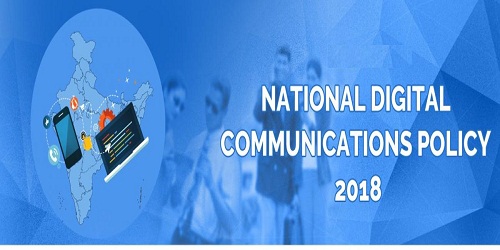On May 1, 2018, Department of Telecom uploaded the draft of National Digital Communications Policy 2018 on its website for public consultations.
 Salient Features of National Digital Communications Policy 2018:
Salient Features of National Digital Communications Policy 2018:
Spectrum Policy:
The policy recognises spectrum as a key natural resource which is to be utilised for attaining India’s socio-economic goals.
- The policy envisages making adequate spectrum available for the new broadband era.
- It recognises optimal pricing of spectrum in order to ensure sustainable and affordable access to digital communications.
- In order to promote efficiency, process of obtaining permissions from various agencies such as Wireless Planning and Coordination (WPC) and Standing Advisory Committee on Radio Frequency Allocation (SACFA) is to be simplified.
- The policy also talks about constituting a Spectrum Advisory Team (SAT), consisting of experts, industry and academia to facilitate the identification of new bands and applications.
Some of the strategic objectives to be accomplished by 2022:
- Provisioning of Broadband for all.
- Enhancing the contribution of the digital communications sector to eight per cent of India’s Gross Domestic Product (GDP) from around six per cent in 2017.
- Creating four million additional jobs in the digital communications sector.
- To propel India’s rank in the ICT development index to top 50, from 134 in 2017.
- These goals are to be achieved by adhering to the principles of net neutrality.
Other features of National Digital Communications Policy 2018:
In order to ensure quality of services in telecom sector, Government is contemplating to set up an effective institutional mechanism to protect consumers’ interests including a Telecom Ombudsman and a centralised web based complaint redressal system.
- Under ‘National Broadband Mission – Rashtriya Broadband Abhiyan’ government has also set a goal to provide 1Gbps of internet speed to all gram panchayats in India by 2020.
- Use of renewable energy technologies in the communications sector will be encouraged. This includes utilisation of small cell fuel batteries, lithium-ion batteries or other similar technologies.
- The Government will also prepare a roadmap to explore and utilise the opportunities presented by next generation-networks like 5G and emerging technologies like artificial intelligence, internet of things, robotics, cloud computing and machine to machine communications.
AffairsCloud Recommends Oliveboard Mock Test
AffairsCloud Ebook - Support Us to Grow
Govt Jobs by Category
Bank Jobs Notification




